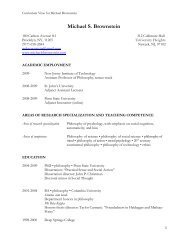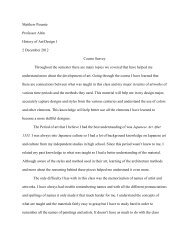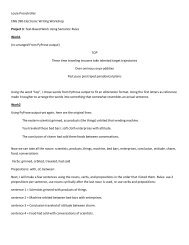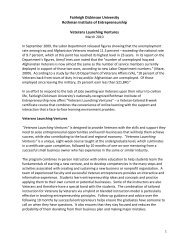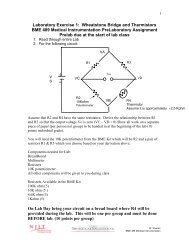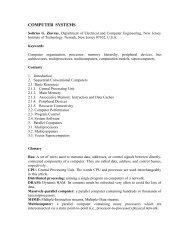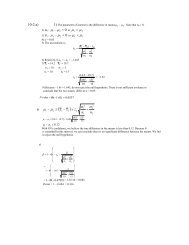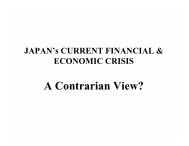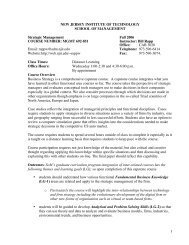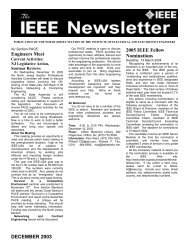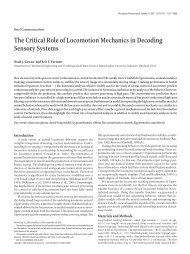On the Average Crossing Rates in Selection Diversity - Njit - New ...
On the Average Crossing Rates in Selection Diversity - Njit - New ...
On the Average Crossing Rates in Selection Diversity - Njit - New ...
You also want an ePaper? Increase the reach of your titles
YUMPU automatically turns print PDFs into web optimized ePapers that Google loves.
PREPARED FOR IEEE TRANSACTIONS ON WIRELESS COMMUNICATIONS (1ST REVISION) 1<br />
<strong>On</strong> <strong>the</strong> <strong>Average</strong> <strong>Cross<strong>in</strong>g</strong> <strong>Rates</strong> <strong>in</strong> <strong>Selection</strong><br />
<strong>Diversity</strong><br />
Hong Zhang, Student Member, IEEE, and Ali Abdi, Member, IEEE<br />
Abstract<br />
This letter presents new results on <strong>the</strong> average cross<strong>in</strong>g rate of <strong>the</strong> comb<strong>in</strong>ed signal of a selection<br />
diversity <strong>in</strong> Rayleigh fad<strong>in</strong>g channels. Exact closed-form expressions are derived for <strong>the</strong> <strong>in</strong>phase zero<br />
cross<strong>in</strong>g rate, <strong>in</strong>phase rate of maxima, phase zero cross<strong>in</strong>g rate, and <strong>the</strong> <strong>in</strong>stantaneous frequency zero<br />
cross<strong>in</strong>g rate of <strong>the</strong> output of <strong>the</strong> selection comb<strong>in</strong>er. The utility of <strong>the</strong> new <strong>the</strong>oretical formulas, validated<br />
by Monte Carlo simulations, are brie y discussed as well.<br />
quency.<br />
Index Terms<br />
Zero cross<strong>in</strong>g rate, selection comb<strong>in</strong><strong>in</strong>g, Rayleigh channels, fad<strong>in</strong>g channels, <strong>in</strong>stantaneous fre-<br />
I. INTRODUCTION<br />
<strong>Diversity</strong> comb<strong>in</strong><strong>in</strong>g techniques are often used to combat <strong>the</strong> effect of fad<strong>in</strong>g and selection<br />
comb<strong>in</strong><strong>in</strong>g (SC) is one of <strong>the</strong> simplest diversity methods [1]. It is well known that <strong>the</strong> average<br />
cross<strong>in</strong>g rate represents <strong>the</strong> fad<strong>in</strong>g rate and effectively quanti es <strong>the</strong> impact of <strong>the</strong> diversity<br />
comb<strong>in</strong>er on channel uctuations [2]. Ano<strong>the</strong>r application is speed/Doppler estimation which is<br />
important for many applications such as handoff, adaptive modulation and equalization, power<br />
control, etc. [1] [7] [11] [12]. However, to <strong>the</strong> best of our knowledge, only <strong>the</strong> envelope level<br />
cross<strong>in</strong>g rate (ELCR) <strong>in</strong> diversity systems has been considered so far [2] [3] [13] [14]. In this<br />
This work was presented <strong>in</strong> part at IEEE Global Telecommunications Conference, Dallas, TX, 2004.<br />
H. Zhang and A. Abdi are with Center for Wireless Communications and Signal Process<strong>in</strong>g Research (CWCSPR), Department<br />
of Electrical and Computer Eng<strong>in</strong>eer<strong>in</strong>g, <strong>New</strong> Jersey Institute of Technology, <strong>New</strong>ark, NJ 07012 USA (emails: hz7@njit.edu,<br />
ali.abdi@njit.edu)<br />
November 26, 2005 DRAFT
PREPARED FOR IEEE TRANSACTIONS ON WIRELESS COMMUNICATIONS (1ST REVISION) 2<br />
letter, closed-form expressions are derived which demonstrate <strong>the</strong> impact of SC on <strong>the</strong> uctuation<br />
rates of <strong>the</strong> <strong>in</strong>phase component, <strong>the</strong> phase, and <strong>the</strong> <strong>in</strong>stantaneous frequency <strong>in</strong> Rayleigh fad<strong>in</strong>g<br />
channels. Monte Carlo simulation results are provided to verify <strong>the</strong> <strong>the</strong>oretical expressions as<br />
well. F<strong>in</strong>ally, application of <strong>the</strong>se results to speed estimation is brie y discussed.<br />
II. SIGNAL AND CHANNEL MODELS<br />
Consider a noisy Rayleigh frequency- at fad<strong>in</strong>g channel and a comb<strong>in</strong>er with L branches.<br />
The received lowpass complex envelope at <strong>the</strong> i-th branch is<br />
zi(t) = hi(t) + ni(t) ; i = 1; 2; :::; L; (1)<br />
where <strong>the</strong> <strong>in</strong>dependent zero-mean complex Gaussian processes hi(t) and ni(t) represent <strong>the</strong><br />
channel ga<strong>in</strong> (assum<strong>in</strong>g a pilot has been transmitted) and <strong>the</strong> additive noise, respectively. In <strong>the</strong><br />
Cartesian coord<strong>in</strong>ates we have<br />
zi(t) = xi(t) + jyi(t); (2)<br />
where j 2 = 1 , and xi(t) and yi(t) are <strong>the</strong> <strong>in</strong>phase and quadrature components, respectively.<br />
Us<strong>in</strong>g <strong>the</strong> polar representation we obta<strong>in</strong><br />
zi(t) = ri(t) exp f j i(t)g ; (3)<br />
where ri(t) and i(t) are <strong>the</strong> envelope and phase of zi(t), de ned by<br />
q<br />
ri(t) = x2 i (t) + y2 i (t); tan i(t) = yi(t)=xi(t): (4)<br />
The autocorrelation function of zi(t) is de ned by Czi(t) = E[zi(t)z i (t + )]=2 with as <strong>the</strong><br />
complex conjugate. We also need <strong>the</strong> n-th spectral moment of zi(t), bi;n, n = 0; 1; 2; :::; given<br />
by [4]<br />
bi;n = (2 ) n<br />
Z 1<br />
1<br />
f n Szi (f)df = dnCzi ( )<br />
jnd n<br />
; (5)<br />
=0<br />
<strong>in</strong> which Szi (f) is <strong>the</strong> power spectral density of zi(t). As an example, assume <strong>the</strong> bandlimit<strong>in</strong>g<br />
receive lter on each branch, with BRX as <strong>the</strong> bandwidth, has a non-zero response only over<br />
<strong>the</strong> range fD < f < fD, where fD is <strong>the</strong> maximum Doppler frequency. Then for Clarke's<br />
isotropic scatter<strong>in</strong>g model [1] with signal power P0 and white noise with N0=2 as <strong>the</strong> two-sided<br />
power spectral density on each branch, respectively, we obta<strong>in</strong> Czi ( ) = P0J0(2 fD )=2 +<br />
N0BRX s<strong>in</strong>c(2BRX )=2, where J0(:) is <strong>the</strong> zero-th order Bessel function of <strong>the</strong> rst k<strong>in</strong>d, BRX =<br />
November 26, 2005 DRAFT
PREPARED FOR IEEE TRANSACTIONS ON WIRELESS COMMUNICATIONS (1ST REVISION) 3<br />
fD , and s<strong>in</strong>c( ) = s<strong>in</strong>( )=( ). This results <strong>in</strong> b0 = P0=2 + N0BRX=2, b1 = b3 = 0,<br />
b2 = 2 P0f 2 D + 2 2 N0B 3 RX =3, and b4 = 3 4 P0f 4 D + 8 4 N0B 5 RX =5, where <strong>the</strong> <strong>in</strong>dex i on bi;n is<br />
omitted, due to assumption of identically distributed branches.<br />
Let z(t), x(t), y(t), r(t), and (t) denote <strong>the</strong> complex envelope, <strong>in</strong>phase part, quadrature part,<br />
envelope, and <strong>the</strong> phase at <strong>the</strong> output of <strong>the</strong> SC, respectively. Then, based on <strong>the</strong> de nition of<br />
an L-branch SC we have [1]<br />
(t) = i(t) if ri(t) = max(frk(t)g L k=1); (6)<br />
where (t) 2 fz(t); x(t); y(t); (t)g represents random process at <strong>the</strong> SC output and i(t) 2<br />
fzi(t); xi(t); yi(t); i(t)g corresponds to <strong>the</strong> i-th branch. In <strong>the</strong> next section we derive closed-<br />
form expressions for <strong>the</strong> zero cross<strong>in</strong>g rates (ZCRs) of x(t), (t), d (t)=dt (<strong>the</strong> <strong>in</strong>stantaneous<br />
frequency), and <strong>the</strong> rate of maxima (ROM) of x(t). The results hold for a large class of fad<strong>in</strong>g<br />
correlations which have even-symmetric power spectra.<br />
III. NEW RESULTS ON THE AVERAGE CROSSING RATES<br />
Given a stationary real random process (t), N ( th; T ) represents <strong>the</strong> number of times that<br />
<strong>the</strong> process crosses <strong>the</strong> threshold level th with positive (or negative) slope, over <strong>the</strong> time <strong>in</strong>terval<br />
T . Also let M (T ) denote <strong>the</strong> number of maxima of <strong>the</strong> process (t), over <strong>the</strong> time <strong>in</strong>terval T .<br />
Based on [5], <strong>the</strong> expected values of N ( th; T ) and M (T ) can be calculated accord<strong>in</strong>g to<br />
Z 1<br />
E[N ( th; T )] = T _ f _ ( th; _ )d _ ; (7)<br />
Z 1<br />
E[M (T )] = T<br />
0<br />
0<br />
f _ (0; )d ; (8)<br />
where f _ ( ; _ ) is <strong>the</strong> jo<strong>in</strong>t probability density function (PDF) of (t) and _ (t), f _ ( _ ; ) is <strong>the</strong><br />
jo<strong>in</strong>t PDF of _ (t) and (t), and dot denotes differentiation with respect to t. In what follows,<br />
we derive closed-form expressions for four cross<strong>in</strong>g rates <strong>in</strong> SC diversity systems: <strong>the</strong> <strong>in</strong>phase<br />
zero cross<strong>in</strong>g rate (IZCR) E[Nx(0; T )]=T , <strong>the</strong> <strong>in</strong>phase rate of maxima (IROM) E[Mx(T )]=T , <strong>the</strong><br />
phase zero cross<strong>in</strong>g rate (PZCR) E[N (0; T )]=T , and <strong>the</strong> <strong>in</strong>stantaneous frequency zero cross<strong>in</strong>g<br />
rate (FZCR) E[N_(0; T )]=T . The branches are <strong>in</strong>dependent and identically distributed (iid) and<br />
odd-numbered spectral moments are zero due to <strong>the</strong> even symmetry of <strong>the</strong> power spectrum <strong>in</strong><br />
each branch.<br />
November 26, 2005 DRAFT
PREPARED FOR IEEE TRANSACTIONS ON WIRELESS COMMUNICATIONS (1ST REVISION) 4<br />
A. IZCR<br />
The covariance matrix of <strong>the</strong> three dimensional Gaussian random vector ! V IZCR = [xi yi _xi] tr ,<br />
with tr as <strong>the</strong> transpose, at <strong>the</strong> i-th branch, is given by [4]<br />
2 3<br />
b0 6<br />
AIZCR = 6 0<br />
4<br />
0<br />
b0<br />
0<br />
0<br />
7 ;<br />
5<br />
(9)<br />
0 0 b2<br />
where <strong>the</strong> subscript i of bi;n is dropped, s<strong>in</strong>ce we have identically distributed branches. Clearly,<br />
<strong>the</strong> PDF of ! V IZCR can be written as<br />
f~ VIZCR (xi; yi; _xi) =<br />
exp<br />
1<br />
2<br />
x 2 i + y 2 i<br />
b0<br />
(2 ) 3=2 b0b 1=2<br />
2<br />
+ _x2 i<br />
b2<br />
: (10)<br />
Ano<strong>the</strong>r random vector of <strong>in</strong>terest is ! W IZCR = [ri xi _xi] tr , whose PDF can be determ<strong>in</strong>ed from<br />
<strong>the</strong> PDF of ! V IZCR <strong>in</strong> (10) as<br />
f WIZCR<br />
~ (ri; xi; _xi) = X f~ VIZCR (xi; yi; _xi)<br />
; (11)<br />
jJIZCR(xi; yi; _xi)j<br />
where JIZCR(xi; yi; _xi) = yi= p x 2 i + y2 i is <strong>the</strong> Jacobian [5] of <strong>the</strong> transformation ! V IZCR !<br />
!<br />
W IZCR. Based on (4), we <strong>the</strong>n obta<strong>in</strong> <strong>the</strong> PDF of ! W IZCR<br />
f ~ WIZCR (ri; xi; _xi) =<br />
ri exp<br />
1<br />
2<br />
r 2 i<br />
b0<br />
p p<br />
2 2 b2 b0 ri + _x2 i<br />
b2<br />
x 2 i<br />
: (12)<br />
Accord<strong>in</strong>g to (34) <strong>in</strong> <strong>the</strong> Appendix, <strong>the</strong> jo<strong>in</strong>t PDF of x(t) and _x(t) at <strong>the</strong> output of <strong>the</strong> L-branch<br />
SC can be shown to be<br />
fx _x(x; _x) =<br />
where m<br />
n<br />
L<br />
p exp<br />
2 b2 b0<br />
_x 2<br />
2b2<br />
XL<br />
1<br />
k=0<br />
L 1<br />
k<br />
( 1) k<br />
Z 1<br />
jxj<br />
r1 exp<br />
= m!=[(m n)!n!]. Equation (13) can be simpli ed to<br />
fx _x(x; _x) = 1<br />
p exp<br />
2 b2<br />
_x 2<br />
2b2<br />
L XL<br />
1<br />
p<br />
2 b0<br />
k=0<br />
L 1<br />
k<br />
p r 2 1<br />
(k + 1)r 2 1<br />
2b0<br />
x 2<br />
( 1) k k + 1<br />
exp x<br />
2b0<br />
2<br />
p<br />
k + 1<br />
dr1; (13)<br />
: (14)<br />
It is <strong>in</strong>terest<strong>in</strong>g to note that <strong>the</strong> <strong>in</strong>phase component of <strong>the</strong> SC complex envelope and its derivative<br />
at any time <strong>in</strong>stant t are <strong>in</strong>dependent. Also, <strong>the</strong> distribution of _x(t) does not depend on L , and<br />
November 26, 2005 DRAFT
PREPARED FOR IEEE TRANSACTIONS ON WIRELESS COMMUNICATIONS (1ST REVISION) 5<br />
still is Gaussian. By substitut<strong>in</strong>g (14) <strong>in</strong>to (7) with xth = 0, we obta<strong>in</strong> <strong>the</strong> average zero cross<strong>in</strong>g<br />
rate of <strong>the</strong> SC <strong>in</strong>phase component as<br />
E[Nx(0; T )]<br />
T<br />
= L<br />
2<br />
r b2<br />
b0<br />
XL<br />
1<br />
k=0<br />
L 1<br />
k<br />
( 1) k<br />
p k + 1 : (15)<br />
In <strong>the</strong> absence of noise, with isotropic scatter<strong>in</strong>g and L = 1, (15) reduces to <strong>the</strong> well-known<br />
<strong>in</strong>phase zero cross<strong>in</strong>g rate p 2fD=2 [1].<br />
B. IROM<br />
Here we de ne two random vectors ! V IROM = [xi xi yi _xi] tr and ! W IROM = [ri _xi xi i] tr .<br />
The covariance matrix of <strong>the</strong> Gaussian vector ! V IROM is [4]<br />
2<br />
b0 b2 0 0<br />
6 b2 b4 0 0<br />
AIROM = 6<br />
4 0 0 b0 0<br />
3<br />
7 :<br />
7<br />
5<br />
(16)<br />
0 0 0 b2<br />
Then <strong>the</strong> PDF of ! V IROM can be written as<br />
f~ VIROM (xi; xi,yi; _xi) =<br />
exp<br />
1<br />
2 ~ V tr 1<br />
IROM AIROM ~ VIROM<br />
4 2p det(AIROM)<br />
; (17)<br />
where det(:) is <strong>the</strong> determ<strong>in</strong>ant. The Jacobian of <strong>the</strong> transformation ! V IROM ! ! W IROM is<br />
JIROM(xi; xi; yi; _xi) = p x 2 i + y2 i = ri. So, we obta<strong>in</strong> <strong>the</strong> PDF of ! W IROM as<br />
f ~ WIROM (ri; _xi; xi, i) =<br />
ri<br />
4 2pdet(AIROM) exp b32r 2 i s<strong>in</strong>2 i b2 0b2x2 i 2b0b2 2rixi cos i<br />
2 det(AIROM)<br />
exp<br />
(b0b2b4r 2 i<br />
b0b 2 2 _x 2 i + b 2 0b4 _x 2 i )<br />
2 det(AIROM)<br />
: (18)<br />
Based on (34) <strong>in</strong> <strong>the</strong> Appendix, <strong>the</strong> jo<strong>in</strong>t PDF of _x(t) and x(t) at <strong>the</strong> output of <strong>the</strong> L-branch<br />
SC can be expressed as<br />
XL<br />
1<br />
f _xx( _x; x) =L<br />
k=0<br />
L 1<br />
k<br />
= 1<br />
p exp<br />
2 b2<br />
Z 2 Z 1<br />
0<br />
0<br />
exp<br />
( 1) k<br />
Z 1<br />
_x 2<br />
2b2<br />
0<br />
Z 2<br />
0<br />
L<br />
p 2 b0B exp<br />
b2x cos 1<br />
r1<br />
B<br />
f ~ WIROM (r1; _x; x; 1) exp<br />
b0<br />
2B x2<br />
k + 1<br />
2b0<br />
XL<br />
1<br />
k=0<br />
+ b2 2 cos 2 1<br />
2b0B<br />
L 1<br />
k<br />
kr 2 1<br />
2b0<br />
( 1) k<br />
d 1dr1<br />
r 2 1 r1dr1d 1; (19)<br />
November 26, 2005 DRAFT
PREPARED FOR IEEE TRANSACTIONS ON WIRELESS COMMUNICATIONS (1ST REVISION) 6<br />
where B = b0b4 b 2 2. Note that at any given time t, random variables _x and x are <strong>in</strong>dependent,<br />
and _x is Gaussian, as observed <strong>in</strong> (14), with zero mean and variance b2. After substitut<strong>in</strong>g (19)<br />
<strong>in</strong>to (8) and some lengthy calculations, nally we obta<strong>in</strong> <strong>the</strong> average rate of maxima of <strong>the</strong> SC<br />
<strong>in</strong>phase component<br />
E[Mx(T )]<br />
T<br />
= L<br />
2<br />
XL<br />
1<br />
k=0<br />
4B 3=2<br />
L 1<br />
k<br />
3 b 1=2<br />
0 b 5=2<br />
2<br />
Z 2<br />
0<br />
( 1) k<br />
2F1<br />
(<br />
B<br />
p<br />
(k + 1) 2b0b2B + (k + 1)b0b3 +<br />
2<br />
3 5<br />
; 2;<br />
2 2 ;<br />
cos2 (k + 1)B<br />
b 2 2 cos 2<br />
d<br />
9<br />
>=<br />
b 1=2<br />
2<br />
b 1=2<br />
0 (k + 1) 3=2<br />
; (20)<br />
>;<br />
where 2F1(:; :; :; :) is <strong>the</strong> hypergeometric function [6]. For L = 1, with noise-free isotropic<br />
scatter<strong>in</strong>g, (20) reduces to p 3fD=2, <strong>the</strong> IROM derived <strong>in</strong> [7].<br />
C. PZCR<br />
The jo<strong>in</strong>t PDF of <strong>the</strong> vector ! W P ZCR = [ri i _ i] tr is given <strong>in</strong> [8]<br />
f ~ WP ZCR (ri; i; _ i) =<br />
r 2 i exp<br />
Substitution of (21) <strong>in</strong>to (34) from <strong>the</strong> Appendix leads to<br />
f _( ; _ ) = L<br />
4<br />
r b0<br />
b2<br />
XL<br />
1<br />
k=0<br />
1<br />
r2 i + b0<br />
r2 i<br />
_ 2<br />
i<br />
2b0 b2<br />
(2 ) 3=2 (b2 0b2) 1=2 : (21)<br />
L 1<br />
k<br />
( 1) k<br />
k + 1 + b0 _ 2<br />
b2<br />
: (22)<br />
3=2<br />
Interest<strong>in</strong>gly, and _ are <strong>in</strong>dependent, is uniformly distributed over ( ; ], and <strong>the</strong> PDF of<br />
_ is consistent with <strong>the</strong> result given <strong>in</strong> [9]. By substitut<strong>in</strong>g (22) <strong>in</strong>to (7), 1 we obta<strong>in</strong> <strong>the</strong> average<br />
zero cross<strong>in</strong>g rate of <strong>the</strong> SC phase<br />
E[N (0; T )]<br />
T<br />
= L<br />
4<br />
r b2<br />
b0<br />
XL<br />
1<br />
k=0<br />
L 1<br />
k<br />
( 1) k<br />
p k + 1 : 2<br />
Note that for L = 1 and <strong>the</strong> no-noise isotropic scatter<strong>in</strong>g scenario, (23) simpli es to p 2fD=4,<br />
which is consistent with <strong>the</strong> result that one can derive from [8].<br />
1 S<strong>in</strong>ce (22) does not depend on , (23) is valid for any _ th. To simplify <strong>the</strong> notation, _ th = 0 is chosen <strong>in</strong> (23).<br />
2 For = 0 and , we have y = r s<strong>in</strong> = 0. So, E[Ny(0; T )] = E[N (0; T )] + E[N ( ; T )], as we always have r > 0. <strong>On</strong><br />
<strong>the</strong> o<strong>the</strong>r hand, s<strong>in</strong>ce (22) does not depend on , we get E[N (0; T )] = E[N ( ; T )]. Therefore E[N (0; T )] = E[Ny(0; T )]=2,<br />
which agrees with <strong>the</strong> fact that (23) is half of (15).<br />
November 26, 2005 DRAFT<br />
(23)
PREPARED FOR IEEE TRANSACTIONS ON WIRELESS COMMUNICATIONS (1ST REVISION) 7<br />
D. FZCR<br />
We de ne <strong>the</strong> random vector ! W F ZCR = [ri i _ i i] tr , whose PDF is given by [8]<br />
(<br />
f ~ WF ZCR (ri; i; _ i; i) =<br />
r 3 i<br />
(2 ) 2 (b0b2B + 4b 2 0b 2 2<br />
2 _<br />
i ) 1<br />
2<br />
exp<br />
r 2 i<br />
2b0<br />
1 + b0<br />
b2<br />
_ 2<br />
i +<br />
b 2 0<br />
2<br />
i<br />
B + 4b0b2<br />
As before, by substitut<strong>in</strong>g (24) <strong>in</strong>to (34) <strong>in</strong> <strong>the</strong> Appendix and some simpli cations, we obta<strong>in</strong><br />
<strong>the</strong> jo<strong>in</strong>t PDF of _ (t) and (t) at <strong>the</strong> output of <strong>the</strong> L-branch SC<br />
f_ ( _ ; ) =<br />
L<br />
4 b0b2B + 4b2 0b2 2 _<br />
2<br />
(<br />
1<br />
k + 1 +<br />
2b0<br />
b0<br />
b2<br />
1<br />
2<br />
XL<br />
1<br />
k=0<br />
L 1<br />
k<br />
b 2 0<br />
_ 2 +<br />
2<br />
B + 4b0b2<br />
_<br />
2<br />
( 1) k<br />
!) 2<br />
After substitut<strong>in</strong>g (25) <strong>in</strong>to (7) with _ th = 0, we obta<strong>in</strong> <strong>the</strong> average zero cross<strong>in</strong>g rate of <strong>the</strong> SC<br />
<strong>in</strong>stantaneous frequency<br />
E[N_(0; T )]<br />
T<br />
= 1<br />
2<br />
r b4<br />
b2<br />
b2<br />
b0<br />
: 3<br />
_ 2<br />
i<br />
!)<br />
:<br />
(24)<br />
(25)<br />
; (26)<br />
which <strong>in</strong>terest<strong>in</strong>gly, does not depend on L. For <strong>the</strong> noise-free and isotropic scatter<strong>in</strong>g case, (26)<br />
reduces to fD=2, which for a s<strong>in</strong>gle branch, can be derived from [8].<br />
IV. SIMULATION RESULTS AND CONCLUSION<br />
To verify <strong>the</strong> four new cross<strong>in</strong>g rate expressions, Monte Carlo simulations us<strong>in</strong>g <strong>the</strong> spectral<br />
method [10] have been conducted. In each simulation, we have generated 100 <strong>in</strong>dependent<br />
realizations of L iid zero-mean complex Gaussian processes, with 10000 complex samples<br />
per realization, over T = 1 second. The simulated autocorrelation function at each branch is<br />
P0J0(2 fD )=2 with P0 = 1. As illustrated <strong>in</strong> Fig. 1, <strong>the</strong>re is a perfect agreement between <strong>the</strong><br />
<strong>the</strong>oretical and simulation results. Note that <strong>the</strong> cross<strong>in</strong>g rates are normalized by fD <strong>in</strong> Fig. 1.<br />
When <strong>the</strong>re is no noise, it is easy to show that all <strong>the</strong>se closed-form expressions are l<strong>in</strong>ear<br />
functions of fD, so that <strong>the</strong>y can be used for speed estimation [12]. <strong>On</strong>e also observes that<br />
some cross<strong>in</strong>g rates of <strong>the</strong> comb<strong>in</strong>ed signal do not necessarily decrease, 4 as <strong>the</strong> diversity order<br />
3 By <strong>in</strong>tegrat<strong>in</strong>g (25) with respect to , <strong>the</strong> PDF of _ can be obta<strong>in</strong>ed, which agrees with <strong>the</strong> expression given <strong>in</strong> [9].<br />
4 The ELCR goes to zero as L ! 1 [3].<br />
November 26, 2005 DRAFT
PREPARED FOR IEEE TRANSACTIONS ON WIRELESS COMMUNICATIONS (1ST REVISION) 8<br />
<strong>in</strong>creases, as shown by IROM and FZCR <strong>in</strong> Fig. 1. Fur<strong>the</strong>rmore, for a given Doppler, IROM,<br />
IZCR, and PZCR can be utilized to measure <strong>the</strong> uctuation rate of <strong>the</strong> comb<strong>in</strong>ed signal versus<br />
<strong>the</strong> number of branches, whereas FZCR can not.<br />
that<br />
APPENDIX<br />
DERIVATION OF THE JOINT PDF OF THE COMBINER OUTPUT AND ITS DERIVATIVE<br />
Accord<strong>in</strong>g to (6), <strong>the</strong> SC diversity system produces <strong>the</strong> signal (t) and its derivative _ (t) such<br />
(t) = i(t) and _ (t) = _ i(t) if ri(t) = max(frk(t)g L k=1); (27)<br />
which means <strong>the</strong> output at time <strong>in</strong>stant t is com<strong>in</strong>g from <strong>the</strong> branch with <strong>the</strong> largest <strong>in</strong>stantaneous<br />
envelope. Of course i may change as t changes.<br />
We de ne <strong>the</strong> event ei = f : ri(t) = max(frk(t)gL k=1 )g, i = 1; 2; :::; L, with <strong>the</strong> probability<br />
P (ei), where represents a po<strong>in</strong>t of <strong>the</strong> sample space. Based on <strong>the</strong> total probability <strong>the</strong>orem<br />
[5], <strong>the</strong> jo<strong>in</strong>t distribution function of (t) and _ (t) can be written as<br />
F ( ; _ ) =<br />
where F ( ; _ jei) = P ( i ; _ i _ jei). This results <strong>in</strong><br />
F ( ; _ ) =<br />
With iid branches, (29) simpli es to<br />
LX<br />
F ( ; _ jei)P (ei); (28)<br />
i=1<br />
LX<br />
P ( i ; _ i _ ; ei): (29)<br />
i=1<br />
F ( ; _ ) = LP ( 1 ; _ 1 _ ; e1)<br />
= LP ( 1 ; _ 1 _ ; r2 < r1; r3 < r1; :::; rL < r1)<br />
Z 1<br />
= L P ( 1<br />
0<br />
Z 1<br />
; _ 1 _ ; r2 < r1; r3 < r1; :::; rL < r1jr1)fr1(r1)dr1<br />
= L P ( 1 ; _ 1 _ jr1)P L 1 (r2 < r1jr1)fr1(r1)dr1: (30)<br />
0<br />
S<strong>in</strong>ce <strong>the</strong> envelope of each branch is Rayleigh distributed, we obta<strong>in</strong><br />
P (r2 < r1jr1) =<br />
Z r1<br />
r2<br />
0<br />
b0<br />
exp<br />
r 2 2<br />
2b0<br />
dr2 = 1 exp<br />
r 2 1<br />
2b0<br />
; (31)<br />
November 26, 2005 DRAFT
PREPARED FOR IEEE TRANSACTIONS ON WIRELESS COMMUNICATIONS (1ST REVISION) 9<br />
which after substitution <strong>in</strong> (30) and us<strong>in</strong>g <strong>the</strong> b<strong>in</strong>omial expansion, simpli es (30) to<br />
XL<br />
1<br />
F ( ; _ ) = L<br />
L 1<br />
k<br />
( 1) k<br />
Z 1<br />
exp<br />
k<br />
r<br />
2b0<br />
2 1 P ( 1 ; _ 1 _ jr1)fr1(r1)dr1: (32)<br />
k=0<br />
0<br />
By tak<strong>in</strong>g <strong>the</strong> derivative of (32) with respect to and _ we obta<strong>in</strong> <strong>the</strong> jo<strong>in</strong>t PDF of (t) and<br />
_ (t)<br />
XL<br />
1<br />
f _ ( ; _ ) = L<br />
k=0<br />
L 1<br />
k<br />
( 1) k<br />
Z 1<br />
exp<br />
0<br />
k<br />
2b0<br />
r 2 1 f 1 _ 1 ( ; _ jr1)fr1(r1)dr1; (33)<br />
where f 1 _ 1 (:; :jr1) is <strong>the</strong> jo<strong>in</strong>t PDF of (t) and _ (t), conditioned on r1(t). Equation (33) can<br />
be written <strong>in</strong> <strong>the</strong> follow<strong>in</strong>g more compact form<br />
XL<br />
1<br />
f _ ( ; _ ) = L<br />
L 1<br />
k<br />
( 1) k<br />
Z 1<br />
k=0<br />
0<br />
fr1 1 _ 1 (r1; ; _ ) exp<br />
where fr1 1 _ 1 (:; :; :) is <strong>the</strong> jo<strong>in</strong>t PDF of r1(t), 1(t), and _ 1(t).<br />
REFERENCES<br />
[1] G. L. Stuber, Pr<strong>in</strong>ciples of Mobile Communication, 2nd ed., Boston, MA: Kluwer, 2001.<br />
k<br />
2b0<br />
r 2 1 dr1; (34)<br />
[2] A. Abdi and M. Kaveh, “Level cross<strong>in</strong>g rate <strong>in</strong> terms of <strong>the</strong> characteristic function: A new approach for calculat<strong>in</strong>g <strong>the</strong><br />
fad<strong>in</strong>g rate <strong>in</strong> diversity systems,” IEEE Trans. Commun., vol. 50, pp. 1397-1400, 2002.<br />
[3] X. Dong and N. C. Beaulieu, “<strong>Average</strong> level cross<strong>in</strong>g rate and average fade duration of selection diversity,” IEEE Comm.<br />
Lett., vol. 5, pp. 396-398, 2001.<br />
[4] A. Abdi, “<strong>On</strong> <strong>the</strong> second derivative of a Gaussian process envelope,” IEEE Trans. Inform. Theory, vol. 48, pp. 1226-1231,<br />
2002.<br />
[5] A. Papoulis, Probability, Random Variables, and Stochastic Processes, 3rd ed., S<strong>in</strong>gapore: McGraw-Hill, 1991.<br />
[6] I. S. Gradshteyn and I. M. Ryzhik, Table of Integrals, Series, and Products, 5th ed., A. Jeffery, Ed., San Diego, CA:<br />
Academic, 1994.<br />
[7] A. Abdi, H. Zhang, and C. Tepedelenlioglu, “Speed estimation techniques <strong>in</strong> cellular systems: Uni ed performance<br />
analysis,” <strong>in</strong> Proc. IEEE Vehic. Technol. Conf., Orlando, FL, 2003, pp. 1522-1526.<br />
[8] S. O. Rice, “Statistical properties of a s<strong>in</strong>e wave plus noise,” Bell Syst. Tech. J., vol. 27, pp. 109-157, 1948.<br />
[9] B. R. Davis, “Random FM <strong>in</strong> mobile radio with diversity,” IEEE Trans. Commun., vol.19, pp. 1259-1267, 1971.<br />
[10] K. Acolatse and A. Abdi, “Ef cient simulation of space-time correlated MIMO mobile fad<strong>in</strong>g channels,” <strong>in</strong> Proc. IEEE<br />
Vehic. Technol. Conf., Orlando, FL, 2003, pp. 652-656.<br />
[11] M. J. Chu and W. E. Stark, “Effect of mobile velocity on communications <strong>in</strong> fad<strong>in</strong>g channels,” <strong>in</strong> IEEE Trans. Vehic.<br />
Technol., vol. 49, pp. 202-210, 2000.<br />
[12] H. Zhang and A. Abdi, “Mobile speed estimation us<strong>in</strong>g diversity comb<strong>in</strong><strong>in</strong>g <strong>in</strong> fad<strong>in</strong>g channels,” <strong>in</strong> Proc. IEEE Global<br />
Telecommun. Conf., Dallas, TX, 2004, pp. 3685-3689.<br />
[13] G. Fraidenraich, M. D. Yacoub, and J. S. S. Filho, “Second-order statistics of maximal-ratio and equal-ga<strong>in</strong> comb<strong>in</strong><strong>in</strong>g <strong>in</strong><br />
Weibull Fad<strong>in</strong>g,” IEEE Comm. Lett., vol. 9, pp. 499-501, 2005.<br />
November 26, 2005 DRAFT
PREPARED FOR IEEE TRANSACTIONS ON WIRELESS COMMUNICATIONS (1ST REVISION) 10<br />
Normalized <strong>Cross<strong>in</strong>g</strong> Rate<br />
1.5<br />
1<br />
0.5<br />
IROM <strong>the</strong><br />
IROM sim<br />
FZCR <strong>the</strong><br />
FZCR sim<br />
IZCR <strong>the</strong><br />
IZCR sim<br />
PZCR <strong>the</strong><br />
PZCR sim<br />
0<br />
1 2 3 4 5 6 7 8 9 10<br />
L<br />
Fig. 1. Normalized average zero cross<strong>in</strong>g rates versus <strong>the</strong> number of branches L.<br />
[14] N. C. Beaulieu and X. Dong, “Level cross<strong>in</strong>g rate and average fad<strong>in</strong>g duration of mrc and egc diversity <strong>in</strong> Ricean fad<strong>in</strong>g,”<br />
IEEE Trans. Commun., vol.51, pp. 722-726, 2003.<br />
November 26, 2005 DRAFT



